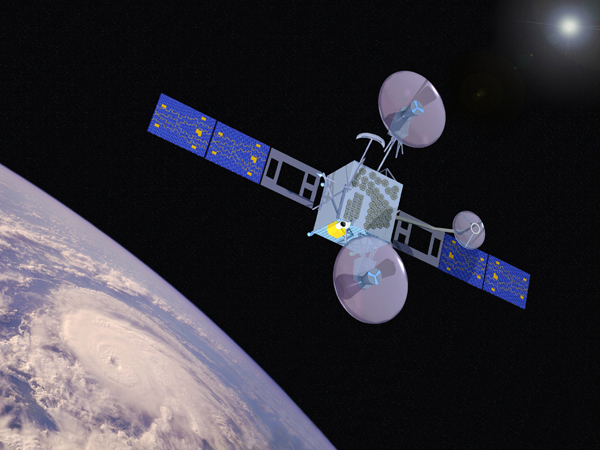The "fasten seatbelts" light turns off, and you get up to ask the stewardess for a pillow; it's going to be a long flight. Only a kilometer ahead in the cloudless sky, a downward draft of sheering winds looms. When the plane hits these winds, the "turbulence" will shake the cabin violently and you could be seriously hurt.
You don't know about those winds, of course, and neither does the pilot. Today's weather satellites can't see winds in clear skies: they rely on the motion of clouds to infer which way the winds are blowing.
"Believe it or not, their best indication of wind sheer right now is warnings from aircraft that have gone through it ahead of them," says Bill Smith of NASA's Langley Research Center.
But a new satellite technology being pioneered by NASA and NOAA could improve this shaky situation. It's called GIFTS, short for Geosynchronous Imaging Fourier Transform Spectrometer. GIFTS is an infra-red sensor that can detect winds in cloudless skies by watching the motions of atmospheric water vapor. Water vapor is mostly invisible to the human eye, but it reveals itself to GIFTS by the infra-red radiation it absorbs.
Smith is the lead scientist for EO-3, a satellite designed to test out this new technology. Slated for launch in 2005 or 2006, EO-3 will carry GIFTS to Earth orbit where it can produce 3-dimensional movies of winds in the atmosphere below.
These wind data will not only improve safety, but also help the airlines save money. Knowing the winds along a flight route allows airlines to adjust the plane's fuel load accordingly, thus reducing the weight that the engines must lift. Saved fuel means saved money and less pollution.
GIFTS can help planes avoid another potentially lethal problem, too: Ice forming on their wings. If a cloud contains "supercooled" water droplets whose temperature is below freezing, those droplets will form ice on the wings of planes that pass through it. By looking at about 1700 different frequencies of the light coming from clouds, GIFTS can measure the temperature of the cloud top and determine whether it contains water droplets that could cause aircraft icing. With information from GIFTS in hand, pilots can simply avoid clouds that appear dangerous.
Once EO-3 demonstrates the accuracy of GIFTS, airlines will be able to capitalize on this potential to make flying a cheaper and safer experience.
Learn more about the GIFTS instrument and other advanced technologies being tested on the EO-3 mission at nmp.jpl.nasa.gov/eo3. Kids can go to The Space Place to play a data compression game related to EO-3 at spaceplace.nasa.gov/eo3_compression.htm .
This article was provided by the Jet Propulsion Laboratory, California Institute of Technology, under a contract with the National Aeronautics and Space Administration.

EO-3,
carrying the GIFTS instrument, will be in a geosynchronous orbit for
extended monitoring of large regions of our planet and enabling
observation of weather patterns at higher resolution than possible
with existing geostationary satellites.

